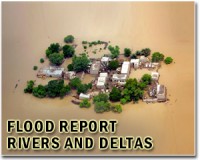| . |  |
. |
Sydney (AFP) Jan 5, 2011 Australia's spectacular Great Barrier Reef is under threat from massive floods swamping the country's northeast which are pouring harmful debris and sediment into the sea, an expert said Wednesday. The full impact of the floods, which are rushing huge volumes of water into the pristine surrounds of the world's largest coral reef, is not yet known, but the influx will stress the colourful corals, said Michelle Devlin. "This does impact on the reef. It just impacts on the reef's resilience so you get very stressed corals, you get stressed sea grass," Devlin, a researcher at James Cook University in northern Queensland, told AFP. "So let's just say that a big cyclone came along, knocked them all out. They might not recover so well because they are already very stressed." Devlin said while the rivers have always poured into the reef, the floods were no longer bringing just rainwater but also sediment, nutrients and pesticides. "Top soil will run straight off into the water and that will come straight out into the Great Barrier Reef," said the researcher, who chased the flood plumes by boat to take samples and track the extent of the damage. "There's a lot of water around and already it would be influencing the reef," she said, describing the mixture of fresh, warm water, nutrient-heavy soil and pesticide run-offs as a harmful "cocktail" for the corals. "There is just going to be this cocktail of water containing a lot of things that they (the corals) wouldn't necessarily have seen before. It is fresh, warm water and that will stress corals out as well." Devlin said flood plumes were visible near the coastal city of Rockhampton, where floods have virtually cut off the town of 75,000, and already stretched to up to 40 kilometres (25 miles) offshore. As more floodwaters brought by weeks of torrential rains make their way to the coast, the dirty river water will pour into the reef for weeks, enabling the plume to extend for hundreds of kilometres, she said. And although the worst of the flooding is at the southern end of the Great Barrier Reef Marine Park, experts expect the floodwaters to drift towards the Whitsunday Islands, a tourist hotspot at centre of the colourful attraction. Already the plume is at the scenic Keppel islands north of Rockhampton and Devlin said these would likely bear the brunt of the flood impact. "I think the Keppels reefs... they will have quite high mortality," she said. Delvin said the floods were some of the biggest in decades and it was too early to know what impact they would have overall on the Great Barrier Reef Marine Park, which stretches some 2,300 kilometres up the northeast coast. But she said it was possible that sea grass beds -- a key feeding ground for marine creatures such as dugongs -- could be wiped out in some areas while the additional nutrients in the water could allow the crown of thorns starfish -- a pest on the reef -- to flourish. "This is a really massive event," Devlin said. "It has the potential to shift the food web, it has the potential to shift how the reef operates." "But it is a really robust ecosystem," she said of the reef which teems with marine life and boasts hundreds of coral species.
Share This Article With Planet Earth
Related Links Bringing Order To A World Of Disasters When the Earth Quakes A world of storm and tempest
 Australian floods expected to peak at Rockhampton
Australian floods expected to peak at RockhamptonRockhampton, Australia (AFP) Jan 5, 2011 Queensland's cabinet meets in emergency session Wednesday with the floods in the town of Rockhampton expected to peak and fresh thunderstorm warnings issued in the state. Australia's Bureau of Meteorology said that the Fitzroy river was expected to reach a height of 9.4 metres (almost 31 feet) at Rockhampton on Wednesday and would remain above the major flood level for a week after the peak. ... read more |
|
| The content herein, unless otherwise known to be public domain, are Copyright 1995-2010 - SpaceDaily. AFP and UPI Wire Stories are copyright Agence France-Presse and United Press International. ESA Portal Reports are copyright European Space Agency. All NASA sourced material is public domain. Additional copyrights may apply in whole or part to other bona fide parties. Advertising does not imply endorsement,agreement or approval of any opinions, statements or information provided by SpaceDaily on any Web page published or hosted by SpaceDaily. Privacy Statement |